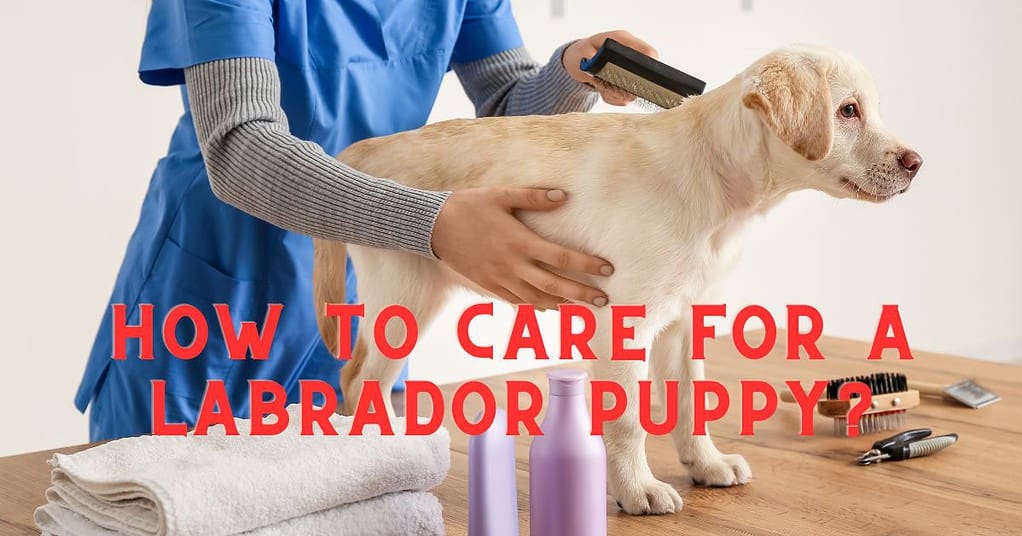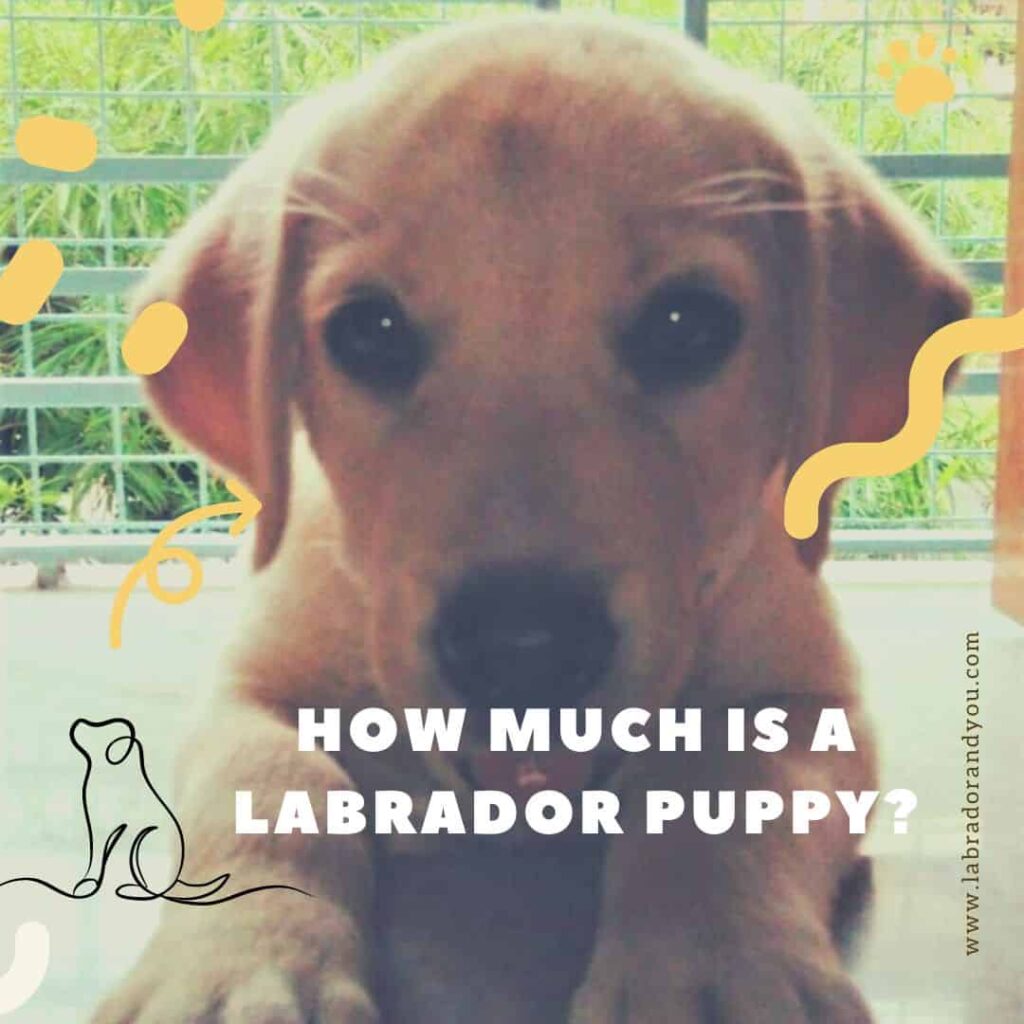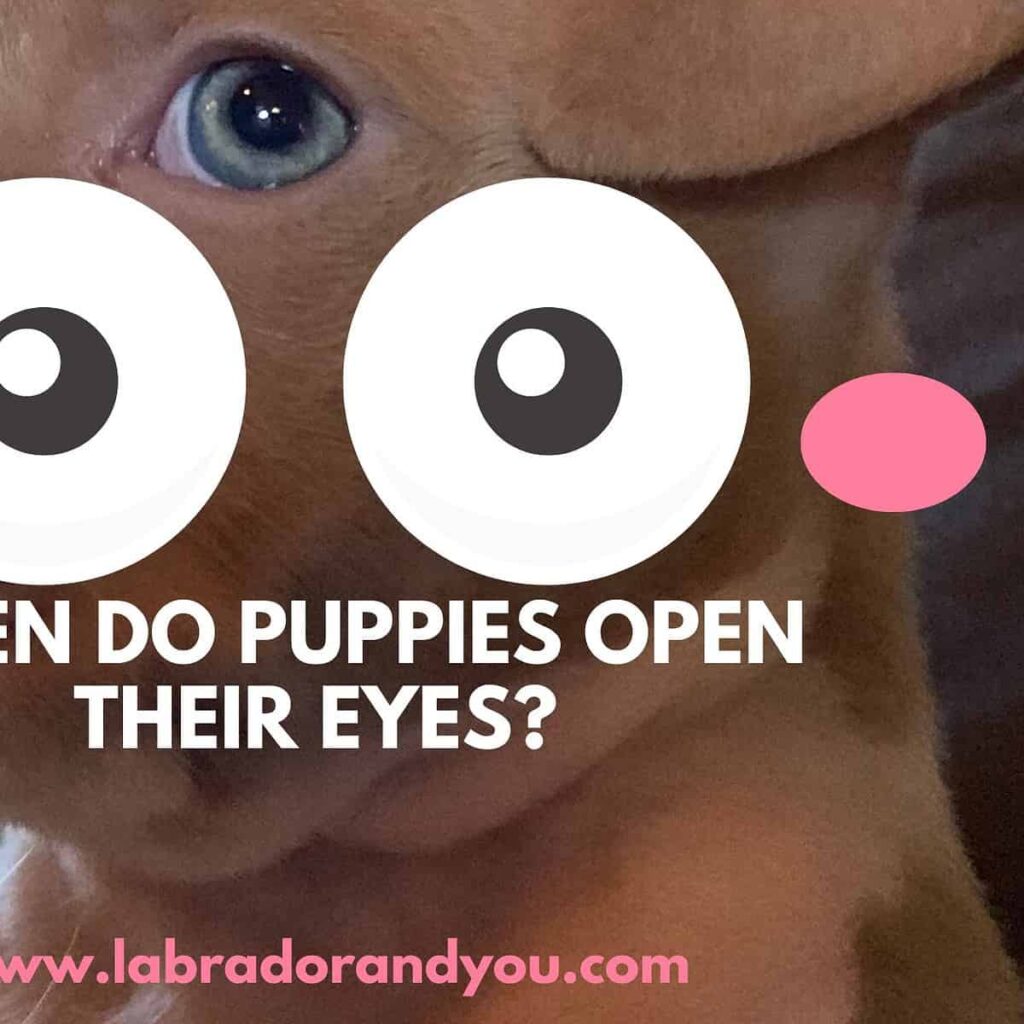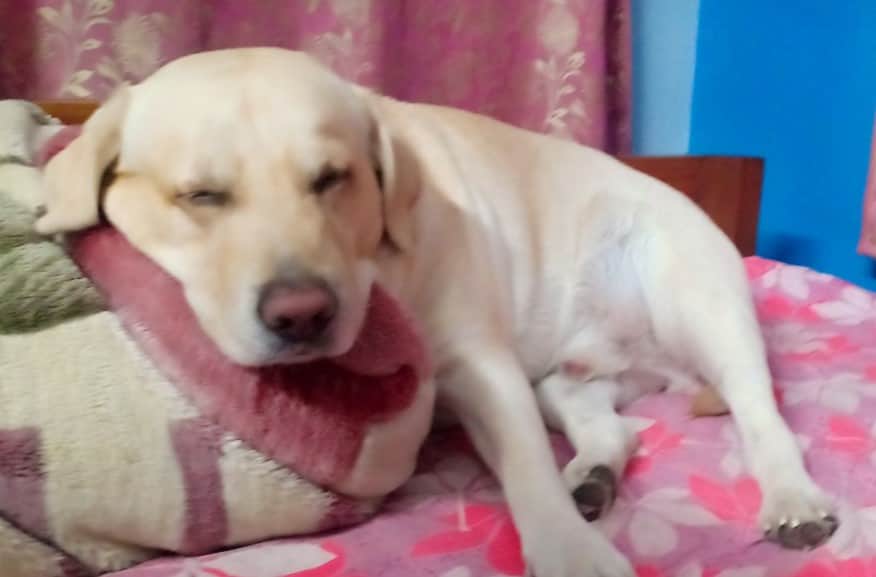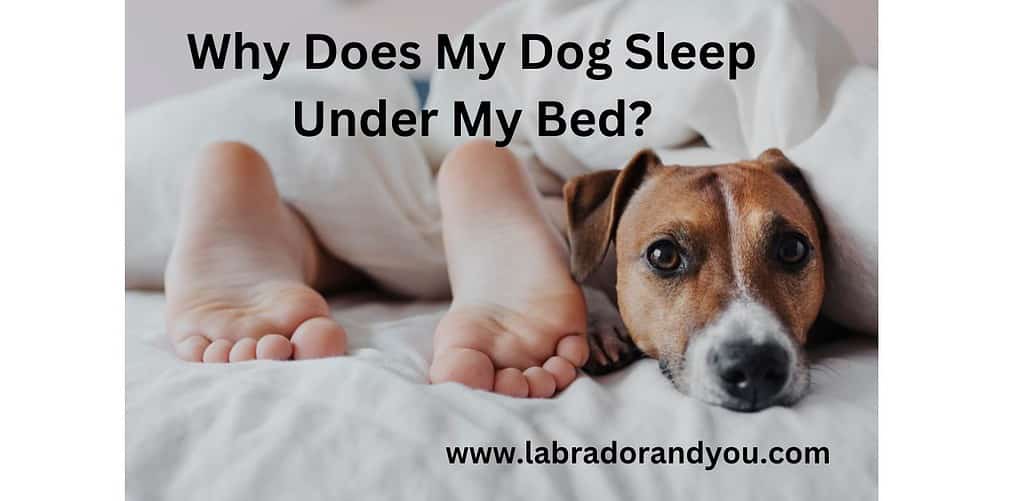Bringing a puppy home is one of the sweetest experiences ever. Caring for your pup is hard work. So, how much to feed a labrador puppy?
Well, A Labrador puppy needs to be fed 3 cups a day. Each cup should be around 8 oz. Maintain this for 4 months. Increase them slightly as they age, with 350-365 gms for a year-old dog.
Feed your lab puppies high-quality food according to our labrador retriever feeding chart. Here’s a daily calorie intake based on the expected adult weight of the Lab:
- Small-size Labs (around 50 lbs when adult) = 900-1100 calories/day
- Medium-size Labs (around 70 lbs when adult) = 1100-1400 calories/day
- Large-size Labs (around 90 lbs when adult) = 1400-1800 calories/day
How Much Do Lab Puppies Grow Every Week?
Firstly, male labs usually grow bigger and heavier than female labs, as evidenced by the labrador retriever growth chart. It shows you when to expect your lab to become a fully grown dog.
Puppies weigh up to 2.25 lbs when first born and then grow rapidly. The fastest growth rate is seen in labrador breed puppies in the first 3-4 months. This is when they need all the nutrients multiple times a day.
Lab Puppy Feeding Chart by Age and Feeding Guide
The puppy you bring home must be weaned off his mother’s milk and adjusted to solid dog food ASAP. This happens in 2 to 4-week-old puppies obtained home from breeders.
Puppies up to two months need to eat between 1.5 to 2 cups of food a day over the course of 4 meals. This would mean feeding your puppy about half a cup of food every 3-4 hours until he’s 2 months old. Home-cooked soft dog foods, mushy food, or soaked kibble are good options for your pup at this stage. The high protein content is key!

How Much To Feed An 8-Week-Old Lab Puppy?
At 8 weeks, a lab puppy is usually weaned and can start eating solid food. Feed them around 3 to 4 times a day, with each meal consisting of about 1/2 to 1 cup of high-quality puppy food.
How Much To Feed A 9-Week-Old Lab Puppy?
Around 9 weeks, you can continue feeding them three to four times a day, with each meal consisting of about 1/2 to 1 cup of puppy food.
How Much Should A 10-Week-Old Lab Eat?
Maintain the same feeding frequency and portion size of 1/2 to 1 cup per meal.
feeding Your labrador puppy Aged 2 to 6 months
At this point, you can reduce your puppy’s meals to three a day. The required food intake is 3 cups daily, so one cup per meal works. Royal Canin puppy food is great for your labrador puppy at this phase. Sometime in the fourth month, your puppy has enough teeth to start chewing solid, unsoaked, dry kibble. You can begin phasing out the soft food and replacing it with hard dog food. The transition is essential – don’t switch all at once! More about that later.
How Much Should A 3-Month-Old Lab Eat?
At this age, you can start transitioning to 3 meals a day. Each meal can consist of approximately 1/2 to 1 1/2 cups of puppy food.
How Much To Feed 12 Week Old Lab Puppy?
Continue with 3 meals a day, and the portion size can range from 1/2 to 1 1/2 cups per meal.
How Much Should A 4-Month-Old Lab Eat?
At 4 months, you can feed your lab puppy 2 to 3 meals a day, ranging from 1 to 2 cups of puppy food.
How Much Should A 5-Month-Old Lab Eat?
Continue with 2 to 3 meals a day, with each meal being about 1 to 2 cups of puppy food.
How Much Should A 6-Month-Old Lab Eat?
Maintain the same meal frequency and consider adjusting the portion size to around 1 to 2 cups per meal.
labrador feeding Aged 6 months to 6 years
Here, you reduce your dog’s meals to 2 a day but increase the total quantity to 3-4 cups. Male labs need more food than female labs because they’re larger.
1.5 to 2.5 cups a meal is ideal for your dog until they’re 6 years old. The two meals should be evenly spaced during the day. Ensure you give your doggo a good mix of yummy nutrients in his dog food. The diet should consist of all the essential nutrients listed above in some form or another.
How Much Should A 7-Month-Old Lab Eat?
Continue with 2 to 3 meals a day, and you can adjust the portion size to about 1 to 2 cups per meal.
How Much Should A 9-Month-Old Lab Eat?
Around 9 months, you can transition to feeding 2 meals a day. Each meal can consist of around 2 to 2.5 cups of puppy food.
11-Month Eating Schedule
By 11 months, you can stick to 2 meals a day, each consisting of 2 to 2.5 cups of puppy food.
How Much To Feed 1 Year-Old Lab?
As your lab puppy reaches 1 year of age, you can begin transitioning to adult dog food. You can continue feeding them 2 meals a day, with each meal ranging from 2 to 3 cups of adult dog food.
How Much Should A 2-Year-Old Lab Eat?
At this point, your lab is considered an adult and should be fully transitioned to adult dog food. You can continue feeding 2 meals a day, adjusting the portion size based on their activity level and weight maintenance, around 2 to 3 cups of adult dog food per meal.
Senior labrador feeding chart (7 years and above adult dogs)
A Labrador retriever becomes lethargic as they age. The amount of food you feed your senior labrador should always be adjusted according to his daily activity level. Don’t feed your senior lab more than 2-3 cups of adult food daily if he’s suffering from health issues like obesity, arthritis, hip dysplasia, etc. If your lab’s activity level is higher when older, feed him about 3-4 cups a day.
What is Considered A Balanced Puppy Food?
The growing period is also the training period for a labrador retriever puppy. Go for leash training, obedience training, potty training, and so on. A complete and balanced diet is key for your lab puppy to be sharp. Let’s look at the various types of pet food you must include in your dog’s diet.
Proteins
Dogs are omnivores! Feeding them meat, fruits, and veggies is a good idea. The best diet for dogs is rich in healthy proteins until they’re several weeks old. Also, it keeps their muscles and heart healthy. Growing puppies need lots of dietary protein for growth and development. Protein builds muscle, and growing puppies need a lot of that.
Carbohydrates
The purpose of carbohydrates is to provide energy. Carbohydrates are a must for lab puppies because they are highly active. Puppies love to run around and play, so they need energy. If the puppy’s food does not meet this requirement, he will become weak and malnourished. Carbohydrates should make up about 20% of your puppy’s diet.
Fiber
If you’re wondering why your dog’s not been pooping alright lately, maybe you should check how much fiber you give him. Enough fiber in the raw food diet is necessary to keep your puppy’s digestive issues at bay. It encourages regular and healthy poop. Fiber-rich diets with dry food control your puppy’s blood sugar and cholesterol.
Omega Fatty Acids
Omega fatty acids are essential. Your pup needs Omega-3 and Omega-6. Omega-3 helps with eyesight and brain function. This is an essential nutrient because labrador retrievers are notorious for developing visual diseases like cataracts. Omega-6 keeps the reproductive organs intact, helps with immune function, and even gives your pup’s coat a gorgeous shine.
Vitamins and Minerals
Puppies need B-complex vitamins and vitamins C, D, and E. Puppy supplements will be good for your pup. They should get these vitamins and minerals from the food he eats as well. Feed your pup vitamin-rich and mineral-rich diets full of amino acids.
Water
About an ounce of water per pound daily. So, if labrador retriever puppies weigh about 10 pounds, they must drink about 10 ounces of water daily. A new puppy would need less water, while a senior labrador retriever needs more. You don’t need to worry much about this as a dog parent. When you keep your dog’s water bowl out in an accessible place, your dog self-regulates and drinks as much water as he needs.
Is homemade food for labrador puppy Great? How To Make?
This is the homemade recipe that we use for our Labrador Sinu. Check it out and let us know if your dog likes it. First, arrange some of the following.
- Lean protein sources (chicken, turkey, beef, etc.)
- Carbohydrates (rice, sweet potatoes, quinoa, etc.)
- Vegetables (carrots, peas, green beans, etc.)
- A source of healthy fats (fish oil, flaxseed oil)
- Supplements as recommended by your vet
Then, follow this cooking process
- Protein: Cook the lean protein source thoroughly. Remove bones, skin, and excess fat. Cut into small, easily digestible pieces.
- Carbohydrates: Cook the chosen carbohydrates until they are soft and easily mashable. For rice, cook it in water until fully cooked. For sweet potatoes or other vegetables, steam or boil until tender.
- Vegetables: Steam or boil the vegetables until they are soft. Chop or mash them into small pieces.
- Mixing: Combine the cooked protein, carbohydrates, and vegetables in a large bowl. Add a small amount of healthy fat source (fish or flaxseed) for essential fatty acids.
- Supplements: If your vet has recommended supplements, add them to the mixture according to their instructions.
- Portioning: Portion out the food based on your puppy’s daily feeding recommendations. Divide the portions into multiple meals throughout the day.
- Storage: Store leftover food in airtight containers in the refrigerator for a few days, or freeze individual portions for longer storage.
how much to feed Your Puppy by weight?
You must adjust your labrador’s daily food intake according to his growth. Look at the lab puppy feeding schedule for labrador puppies of different ages. Each meal needs equal amounts of food spaced out evenly throughout the day.
Your puppy’s teeth are still growing, so it’s difficult for him to chew. Making sure your puppies eat soft food for the first 3 months is advisable. This can be home-cooked food or feeding kibble soaked in water or milk. Each balanced diet must give your puppy the best food he deserves.

How Much Should A 6 Lb Puppy Eat?
For a 6 lb puppy, you might start with around 1/2 to 3/4 cup of puppy food per day, divided into multiple meals.
How Much Food Should A 10-Pound Puppy Eat?
A 10 lb puppy might require around 3/4 to 1 cup of puppy food per day, divided into multiple meals.
How Much To Feed A 20-Pound Puppy?
For a 20 lb puppy, you could consider feeding around 1 1/4 to 1 3/4 cups of puppy food per day, divided into multiple meals.
How Much Should A 30-Pound Puppy Eat?
A 30 lb puppy might need approximately 1 3/4 to 2 1/2 cups of puppy food per day, divided into multiple meals.
How Much Should A 70 Lb Lab Eat?
A 70 lb Labrador Retriever puppy could require around 3 to 4 1/2 cups of puppy food per day, divided into multiple meals. Labs are larger breeds, but individual metabolism and activity levels can vary.
when to switch From Puppy Kibble to dog food?
Remember, puppies are babies. You can’t feed a lab puppy hard food from the beginning of their lives. You need to feed them slowly as their teeth come in. Also, you need to increase or decrease their diets as required as they grow. Knowing how to transition your furry baby from puppy food to adult dog food is essential.
Don’t begin to feed them solid food abruptly one day and expect it to work out fine. It can be uncomfortable for your pup if they can’t chew it yet, and it impact the puppy’s digestive system. So, how to go about this shift?
Start transitioning your dog from hard to soft food after the 4-month mark when your puppy’s teething phase begins to subside. Here’s the best way to introduce puppy food for the labrador retriever breed:
- Week 1: Full portion of soft food (soaked kibble or homemade soft dog food)
- Week 2: ¼ portion of hard food (regular kibble) and ¾ portion of soft or wet puppy food
- Week 3: ½ portion of hard food and ½ portion of soft food
- Week 4: Full portion of hard food
Note that shifting your puppy fully to hard food is unnecessary. Continue to feed him a mixture of both, or try different combinations. Even dogs enjoy a little variety in their meals.
labrador feeding Schedule
Earlier, we’ve seen how frequently to feed a pup at different ages. Now let’s talk more specifics about when to feed your puppy at different weeks of your pup’s life. Create a good feeding schedule for your pup. Be punctual if newborns need 4 dog food meals daily at regular intervals.

How do you prevent overfeeding your large-breed puppy?
Number one
This doesn’t mean they have to keep eating, though. A dog does seem happier when they get a couple of extra cups of dog food, but it can be terrible. As labrador owners, never give in to the lab puppy eyes! They’re experts at begging for more food. A dog’s stomach never really gets full – they’re always hungry.
Number Two
Vary the food quantities you’re giving as per how much physical activity they’re doing. Pay attention to how much your puppy runs around, plays, walks, etc. You can consider a vet or pet nutritionist.
Number Three
As this is a training period, puppies get a lot of treats, even between meals. Alter your feeding quantities. For example, if you’ve had a long training session, reduce the puppy food intake at night to even it out.
Popular Training Treats for Labrador Retrievers
| Treat Brand | Features |
| Zuke’s Mini Naturals | Made with high-quality protein and whole-food ingredients |
| Blue Buffalo Bits | Small and soft, perfect for training and rewards |
| Wellness WellBites | Grain-free and made with real meat and vegetables |
| Old Mother Hubbard | Made with all-natural ingredients, with no artificial preservatives or colors |
A side note: A little extra food is okay once in a while as a bonus after a good training session. Make sure not to make a habit of this.
Avoid Ad Libitum puppy feeding
Ad libitum (or simply, ad lib) puppy feeding is a method wherein your puppy chooses how much he wants to eat. It leads to many unwanted behaviors in labrador puppies, making dogs aggressive, obese, and uncontrollable binge eaters.Excessive body weight can be bad for both small and larger breeds. Dogs are creatures of habit and will quickly adapt to the diet that you set for them.
signs of overfeeding a newborn puppy
Here are some signs of overfeeding newborn puppies:
- Vomiting: Puppies who are overfed may vomit up their food. Other symptoms, such as lethargy, diarrhea, and abdominal pain can accompany this.
- Regurgitation: Regurgitation is similar to vomiting, but the food is not forcefully expelled from the stomach. Instead, it comes back up slowly and easily.
- Diarrhea: Diarrhea is another common sign of overfeeding in puppies. It can be accompanied by mucus or blood in the stool.
- Abdominal distension: Overfed puppies may develop abdominal distension, a swelling of the abdomen. This can be caused by gas build-up or fluid retention.
- Lethargy: Overfed puppies may become lethargic and less active than usual. They may also have difficulty breathing.
- Failure to thrive: In severe cases, overfeeding can lead to failure to thrive. This means that the puppy is not growing or developing properly.
All You Need To Know About Eating Wet Food
All owners want to feed their pups high-quality labrador puppy food. Which type is better, then? Wet food or dry puppy food? The former is healthy and variable, while dry food is easier for the pet parent. Let’s look at the different kinds of wet foods and their benefits for your dog.
Muscle meat:
Although dogs are omnivores, raw feeding is much better than an all-vegetable diet. Their teeth are built to tear into and chew muscle meat.
- Meat is rich in iron content and boosts your dog’s heart health.
- The best meats to give them are chicken, turkey, pork, beef, lamb, and even eggs.
- In corporate raw feeding into your dog’s eating habits.
- Beware of very stinky dog breath with a meat-rich diet.
Raw Edible Bone:
Raw bones can work wonders for bone health. Note that raw bones are different from cooked bones that you may give your pet at home. Cooked bones are usually harder, have fewer nutrients, and can harm your dog’s internal organs via splinters.
Liver:
The liver removes toxins from your pet’s system. It is also a source of fat-free protein. This heightens your dog’s metabolism. Senior dogs tend to love them.
Vegetables:
Different veggies have different nutrients, which are highly beneficial for your labrador retriever. Carrots, celery, and beetroot are great for your fur baby.
Seeds and nuts:
Seeds and nuts are good protein and healthy fats sources, which labrador puppies need for healthy growth. Flax seeds, hemp seeds, chia seeds, sunflower seeds, and occasionally, cashew and peanuts are great additions to your dog’s wet food diet.
fruits for labrador puppy
Fruit-like berries and watermelons are full of antioxidants and have high water content. Fruits can make a healthy snack. Avoid citric fruits like oranges and Keanu.
Foods to Avoid Feeding Your Labrador Retriever
| Food | Reason |
| Chocolate | It can be toxic to dogs. |
| Grapes and raisins | It can cause kidney damage |
| Onions and garlic | Can damage a dog’s red blood cells |
| Avocado | Contains persin, which can be toxic to dogs |
| Alcohol | It can cause vomiting, diarrhea, and even death in dogs |
Wet Food: Pros & Cons
Pros
- You can fulfill your pup’s nutritional needs because it’s usually homemade.
- Wet food is easier to chew and eat for large-breed puppies.
- Meat sources and veggies are home curated, so they are fresher.
Cons
- Time-consuming because it requires cooking. Kibble takes less time.
- The quantities can be confusing and lead to weight gain in your pet.
- It can cost more compared to feeding dry dog food.
Always alternate between wet and dry food. There are no set rules for a healthy life for a dog. The most important thing is how much time you can dedicate to providing high-quality dog food to suit YOUR lab pup’s unique needs. Commercial dog food and puppy food like Royal Canin are also good for your pet
Feeding your labrador puppy: what to be wary about?
Food-guarding
Labrador Retrievers are gun retrievers who were bred for protection and hunting. Although rare, labs can be pretty protective of their food, especially if other dogs are in the house. Food guarding is more familiar with rescues, but there are ways to tackle it.
- Get your dog used to being around him when he’s eating so that he knows you won’t take it away from him.
- Try alternatives like hand-feeding your dog or petting him while he’s eating.
- Talk your pup down if he growls, but if it gets louder and more vicious, step away to avoid being bitten.
- You need to show your dog that you aren’t scared of him but you also don’t want to get hurt at the same time.
Crate Feeding
Crate training is a crucial part of the dog training ritual. After you train your dog, it becomes a safe space for him. Crates are one of the best places to give your lab puppy their dog food.
Right Dog Food And Water Bowl
Ceramic bowls have gorgeous designs but are easily breakable. Avoid glass bowls entirely.
- The best is always stainless steel bowls. They’re durable, easy to clean, and unbreakable. Have two bowls – one for water and one for food.
- Wash the food bowl after each meal and the water bowl once daily to prevent bacteria accumulation.
- Get a third smaller bowl to take along on long walks, for playdates and playtime, or when traveling.
- Consider buying a sleek dog water bottle for this purpose. These can be attached to crates or simply used as is.
Recommended Dog Food Brands
| Brand | Features |
| Hill’s | Supports healthy skin and coat, joint health, and immunity |
| Blue Buffalo | Grain-free and contains high-quality protein sources |
| Royal Canin | Formulated for large breed dogs like Labrador Retrievers |
| Merrick | Made with real meat and no artificial colors or flavors |
Allergies
Labs can also have allergies. Some dogs may be allergic to wheat, macadamia nuts, etc. It can manifest as a runny nose, high volumes of shedding, rashes on the skin, and so on. Different dietary needs are crucial, especially if they display allergy symptoms. Avoid all types of human foods. Consult with your veterinarian and get an allergy test done for your dog if you’re very concerned.
- Tweak your pet’s diet accordingly to prevent allergic breakouts. You can give your lab puppy supplements.
- You can get great quality adult dog food and puppy kibble from companies like Royal Canin Labrador Retriever, Blue Buffalo, Canidae Grain-Free, etc.
- Only adult food must be given to labrador retrievers who have crossed 1.2 years or above.
FAQs
How Many Small Meals Do I Need To Feed My Lab Puppy?
Your puppy needs 4 small meals consisting of half a cup of food per meal till he is 2 months old. From 2 to 6 months, he needs 3 meals daily consisting of 1 cup of food per meal. ( food intake ). From 6 months onwards, you can give your puppy 2 meals daily of 2 cups of dog food per meal.
My Lab Puppy Is Becoming Fat, And He Looks Cute. Is This A Problem?
Yes, this is a major problem! Please don’t overfeed your pup. Fat dogs are adorable but also extremely unhealthy. An adult labrador retriever should weigh at most 60-70 pounds. Labs that are fatter than this stand at the risk of obesity, arthritis, and other lifelong diseases. Refrain from feeding your labrador too many dog treats.
What Human Food Is Bad For Lab Puppy?
- Onions and garlic: surprisingly, anything in the onion and garlic family is incredibly toxic to dogs.
- Meat with bones: if not chewed properly, sharp edges can rupture the throat, stomach lining, intestines, and other parts of the digestive tract.
Other human foods and beverages to avoid giving your dog are alcohol, sugar, citric fruits, and anything with caffeine.
What Is The Ideal Weight For My Labrador?
Your labrador retriever should weigh between 55 to 70 pounds at full adulthood. Male labs are heavier than female labs, so they can fall on either side of the optimal weight spectrum.
What are some healthy treats I can use to feed my labrador retriever?
Some healthy treats for your labrador retriever are cut fruits and vegetables. Carrots, celery, cucumber, beetroot, apples, bananas, and berries (strawberries, blueberries, blackberries, cranberries, etc.) are healthy lab treats. Dogs also love peanut butter! Veggies dipped in peanut butter also make a great snack for your dog.
Should I Give My Labrador Puppy Homemade Food Or Store-Bought Dog Foods?
This is entirely up to you as dog owners. If you have the time and patience to cook meals for your dog, go for it. Store-bought food is easier and is filled with the right nutritional requirements for your lab puppy. It doesn’t require much thought and effort. On the other hand, with the right recipe, home-cooked food works, too.
My Labrador Retrievers Growl At Me When I Go Near His Food Bowl. Any feeding tips?
A dog growling at you when you go near his food bowl is most commonly a trauma response or a way to protect his food. We often see this with rescues. To fix this,
- Sit with your dog while he’s eating.
- Talk to him while he’s eating.
- Touch the bowl while he’s eating but do not pick it up or move it.
- Pet your dog while he’s eating to show him you’re not taking his food away.
- House training your lab puppy is equally important to avoid food aggression.
How Often After A Meal Do Labrador Retrievers Need To Go For Walks?
Labrador Retrievers get piddly after their meals. Schedule your walks around your dog’s eating schedule. Dog owners must take out their lab puppy as frequently as they eat (sometimes even more often to let their energy out) and adult labradors less frequently. 30-40 minutes after their meals is a good time to take your dog for a walk. A lab puppy needs a ton of exercise.
How Much Kibble To Feed A Labrador Puppy?
The amount of kibble you should feed your Labrador puppy will vary depending on their age, weight, and activity level. A good rule of thumb is to start with 2-3 cups of kibble daily and adjust as needed.
What is the best Puppy Food For A Large Breed Puppy?
The best dog foods for lab puppies include those high in protein and low in fillers. Royal Canine and Hill’s diet is one of the best there is for labs.
How Much To Feed A Black Lab Puppy?
The food you should feed a black lab puppy is the same as for any other Labrador puppy. The color doesn’t play a role here.
How Much Food Should A Chocolate Lab Eat?
A chocolate lab puppy should be fed the same food as for any other Labrador puppy. As said earlier, color doesn’t play a role.
How Much To Feed 2-Year-Old Chocolate Lab?
A 2-year-old chocolate lab should eat about 2-3 cups of kibble daily.
When To Stop Labrador Puppy Feeding?
You should stop feeding puppy food to your Labrador at around 12-18 months of age. At this point, their growth plates will have closed, and they will no longer need the extra nutrients in puppy food.
How Do Labradors Age?
Labradors live for 10-12 years. They start to slow down around 7 and may develop health problems in their senior years.
How Much Should I Feed A Lab Who is Overweight?
If your Labrador is overweight, you should reduce their food intake by about 10%. You should also increase their exercise level.
How Much Should A Golden Retriever Puppy Eat?
A golden retriever puppy should eat about 2-3 cups of kibble daily, the same like labs
What Do Lab Breeders Feed Their Dogs?
Lab breeders feed their dogs high-quality dog food specifically formulated for large-breed puppies. They also add some supplements, including chondroitin, to their dogs’ diet.
How Much Water Should A Lab Puppy Drink?
A lab puppy should drink about 1 ounce of water per pound of body weight daily. This amount may increase as they get older and more active.
How Much Exercise Does A Labrador Need?
A labrador needs at least 30 minutes of exercise per day. This can be a combination of walking, running, and playing.
How Long Do Golden Labs Live?
Golden labs live for 10-12 years. They start to slow down around 7 and may develop health problems in their senior years.
How Long Does A Chocolate Lab Live?
Chocolate labs live for 10-12 years like labs of any color.
How Long Does A Black Lab Live?
Black labs live for 10-12 years same as labs of any color
What Age Do Labs Lose Their Baby Teeth?
Labradors lose their baby teeth between 3 and 6 months of age.
When To Stop Feeding A Puppy 3 Times A Day?
You can transition your puppy to eating twice a day at around 6 months of age. By the time they are 1 year old, they should eat only once daily.
When To Stop Feeding Puppy Food Large Breed?
You should stop feeding your large breed puppy food at around 18 months of age. At this point, their growth plates will have closed, and they will no longer need the extra nutrients in puppy food.
Why Are Labs So Hungry?
Labradors are a very active breed of dog, and they need a lot of calories to fuel their energy levels. They are also prone to gaining weight, so keep a close eye on their food intake
Author Profile
- Site Owner And Planning Specialist
-
Aritra, the founder of Labradorandyou.com, is a lifelong dog lover whose passion ignited for Labradors for their loyalty and intelligence. With extensive research and personal experiences, Aritra has become a Labrador expert, offering a rich resource on the breed. Labradorandyou.com provides reliable, timely, and evidence-based information, including Labrador-specific product reviews, training techniques, and care tips.
Labradorandyou.com was born out of Aritra's passion and his desire to share his profound knowledge about the breed. The site serves as a comprehensive resource, offering a wealth of up-to-date information for Labrador owners and enthusiasts alike
Also by the author
-
 FAQNovember 17, 2023How To Adopt An Emotional Support Dog?
FAQNovember 17, 2023How To Adopt An Emotional Support Dog?
-
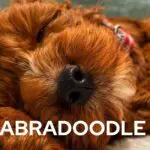 Mix-BreedsNovember 16, 2023Red Labradoodle Ultimate Guide: Breed Facts, Care Tips
Mix-BreedsNovember 16, 2023Red Labradoodle Ultimate Guide: Breed Facts, Care Tips
-
 Top BreedersNovember 8, 2023Breeding Labradors: Everything You Need to Know
Top BreedersNovember 8, 2023Breeding Labradors: Everything You Need to Know
-
 FAQOctober 17, 2023Do Dogs Like Music? Researchers Say Yes! Find Out
FAQOctober 17, 2023Do Dogs Like Music? Researchers Say Yes! Find Out
